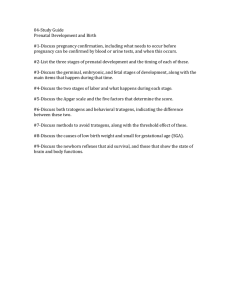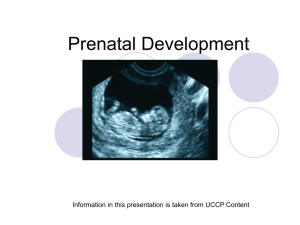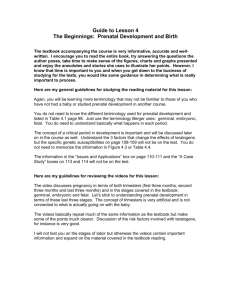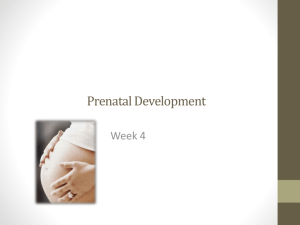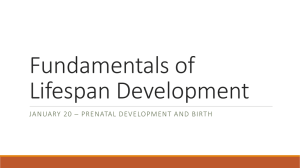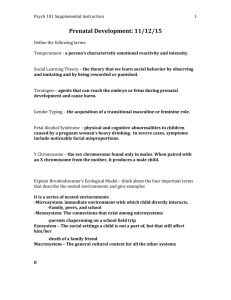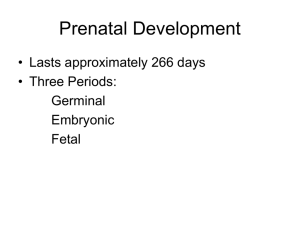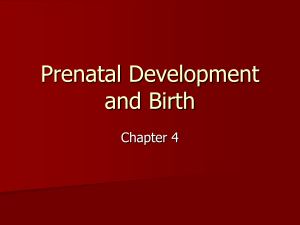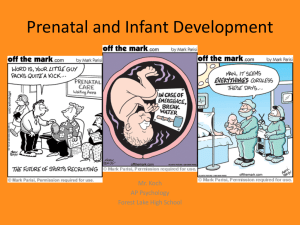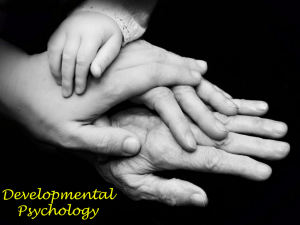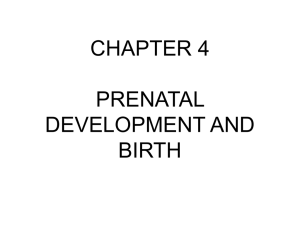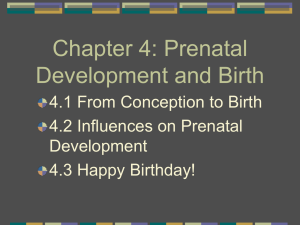Chapter 4 - Prenatal Dev and Birth
advertisement
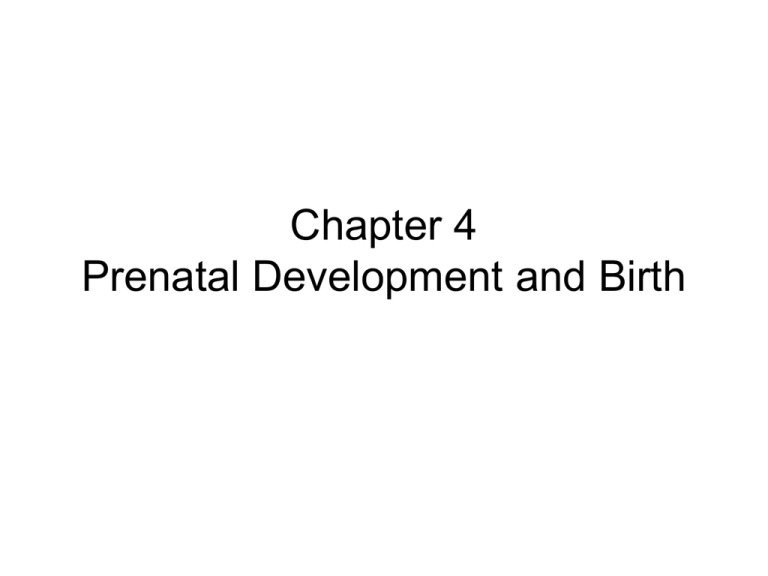
Chapter 4 Prenatal Development and Birth Chapter 4- Prenatal Development • Time of fastest development • Conception – Ova (eggs) travels from ovary to uterus – Penetration by 1 of 300-500 sperm – ZYGOTE (fertilized egg) Prenatal Development and the Zygote LO 7.6 Germinal, embryonic, and fetal periods of pregnancy Menu • Prenatal Stages Germinal period: days 1-14 (0 - 2 weeks) – Zygote’s implantation into uterine wall: 1/2 are successful – Zygote divides many times through mitosis to form blastocyst (about 150 cells) • – Miscarriage: 8-30% (recognized) to 33% (unrecognized) Embryonic period: 3rd to 8th week (3rd week - 2nd month) – Organogenesis – every major organ takes shape – Sexual differentiation – begins during 7th & 8th week Outer Layer of Blastocyst (150 cells) forms: • Amnion – a watertight membrane that fills with • • • fluid that protects the embryo Placenta – provides nourishment by mother’s blood vessels Umbilical cord – connection between embryo and mother Placental barrier – protects developing child from many harmful substances, and allows small molecules exchanged Inner cell mass of blastocyst forms: • • • Ectoderm – (brain and spinal cord) Mesoderm – muscle tissue, cartilage, bone, heart, arteries, kidneys, and gonads Endoderm – gastrointestinal tract, lungs, and bladder Neural plate forms neural tube (bottom is spinal cord) Top of tube forms into forebrain, midbrain, hindbrain Figure 4.3 • Fetal period: 9th week – birth – Proliferation of neurons (250,000 per minute) – Migration of neurons – Differentiation of stem cells Age of viability – around 23-25 weeks (fetus has possibility of surviving outside uterus) 3rd Trimester – myelination Prenatal Development and the Newborn 40 days 45 days 2 months 4 months Prenatal Environment • Teratogen: harmful environmental agent – Harms the developing fetus – Critical Period: Organogenesis – Dosage & duration – Genetic make-up: susceptibility LO 7.6 Germinal, embryonic, and fetal periods of pregnancy Menu Teratogens Thalidomide (for morning sickness) All or parts of limbs missing • Sudden Infant Death Syndrome Fetal Alcohol Syndrome • Low birth weight • Developmental delay • Epilepsy • Poor coordination / fine motor skills • Behavioral problems “Copyright© Allyn & Bacon 2006” 2 six week old infants Normal child FAS Teratogens - Diseases • Rubella (German Measles) – Blind, deaf, heart, brain • Syphilis:miscarriage, blind, deaf, heart, brain – After 18th week • AIDS mothers transmit to babies (15%-35%) – Prenatally, perinatally, postnatally Teratogens – Environmental Hazards • • Radiation: MR, leukemia, cancer, mutations, spontaneous abortions, etc. – Avoid X-rays when pregnant Pollutants – In air and water – Lead - MR (also postnatally) Anoxia – Oxygen shortage –can cause mental retardation or cerebral palsy Postnatal Depression • Baby Blues, mild, common • Postpartum depression: 1/10 – Previous depression common • Children of depressed mothers – Insecurely attached, less responsive – Negative to other children APGAR TEST • Provides a quick assessment of the newborn’s: 1)Heart rate (0-2 points) 2)Respiratory effort (0-2 points) 3)Muscle tone (0-2 points) 4)Color (0-2 points) 5)Reflex irritability (0-2 points) The Apgar test is given immediately and 5 minutes after birth 7 or higher = good shape 4 or lower = at risk The Neonatal Environment • Culture, early socialization, health status – E.g., low birth-weight babies (8% in US) • Less than 5 1/2 lbs or 2500 grams • Strongly linked to low SES • Environment: neonatal intensive care • Risk: blindness, deafness, CP, autism, cognitive, and later academic problems
